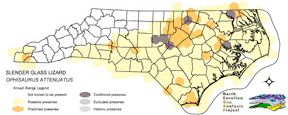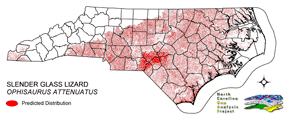
| Taxa: |
| Order: |
| Family: |
| Reptilia |
| Squamata |
| Anguidae |
| NatureServe Global Rank: |
| NatureServe State (NC) Rank: |
| G5 |
| S3S4 |
| Federal Status: |
| NC State Status: |
| --- |
| W1 |


| Land Unit |
| US Fish & Wildlife Service |
| US Forest Service |
| US National Park Service |
| US Department of Defense |
| NC State Parks |
| NC University System |
| NC Wildlife Res. Com. |
| NC Forest Service |
| NC Div. of Coastal Mgmt. |
| Local Governments |
| Non-Governmental Org. |
| Other Public Lands |
| Private Lands |
| GAP Status 1-2 |
| All Protected Lands |
| Statewide |
| Hectares |
| 5,288.67 |
| 12,644.64 |
| 67,172.04 |
| 268.74 |
| 2,768.85 |
| 5,028.66 |
| 26,198.73 |
| 4,795.38 |
| 168.66 |
| 1,089.63 |
| 2,509.29 |
| 1,358.91 |
| 2,503,338.21 |
| 16,088.13 |
| 127,887.30 |
| 2,632,630.41 |
| Acres |
| 13,068.59 |
| 31,245.58 |
| 165,985.69 |
| 664.07 |
| 6,841.98 |
| 12,426.09 |
| 64,738.46 |
| 11,849.64 |
| 416.77 |
| 2,692.53 |
| 6,200.59 |
| 3,357.94 |
| 6,185,882.23 |
| 39,754.63 |
| 316,016.34 |
| 6,505,370.15 |
| % of Dist. on |
| Prot. Lands |
| 4.1 % |
| 9.9 % |
| 52.3 % |
| 0.2 % |
| 2.2 % |
| 3.9 % |
| 19.8 % |
| 3.7 % |
| 0.1 % |
| 1.9 % |
| 1.9 % |
| 0.9 % |
| < 0.1 % |
| 12.6 % |
| ----- |
| ----- |
| % of Dist. on |
| All Lands |
| 0.2 % |
| 0.5 % |
| 2.6 % |
| < 0.1 % |
| 0.1 % |
| 0.2 % |
| 1.0 % |
| 0.2 % |
| < 0.1 % |
| < 0.1 % |
| < 0.1 % |
| < 0.1 % |
| 95.1 % |
| 0.6 % |
| ----- |
| ----- |
|
Occurs most likely over much of the central and eastern portions of the state, although absent on the Outer Banks and hydric portions of the coastal plain; three specimens have also been collected from the southern mountains in Clay and Cherokee counties (Palmer and Braswell 1995). This species is found in open woods or forest edges with thick herbacious ground cover; also in cultivated fields, old field communities and grassy road sides. Habitats are also described as dry grasslands, old fields, pastures, dry, open woods, forest edge, or among rubbish environments in rural areas (Conant & Collins 1991, Palmer & Braswell 1995). Mitchell (1994) states that Slender Glass lizards may inhabit urban and suburban areas or farm sites, but they are found 'always in associations with grassy areas.' NATURE SERVE GLOBAL HABITAT COMMENTS: Open grassland, prairie, woodland edge, open woodland, oak savannas, longleaf pine flatwoods, scrubby areas, fallow fields; near streams and ponds in some areas. Often in areas with sandy soil. Often on roads in spring. During inactivity, occurs in underground burrows. In Kansas, was scarce in heavily grazed pastures, increased as grass increased with removal of grazing, declined as brush and trees replaced grass (Fitch 1989). Eggs are laid underground, under cover, or under grass clumps (Ashton and Ashton 1985); in cavities beneath flat rocks or in abandoned tunnels of small mammals (SCALOPUS, MICROTUS) (Fitch 1989). |
| Code | Name | Description | NC Natural Heritage Program Equivalent |
| 378 | Ocean Beaches | Open beach sand. | Upper Beach |
| 3 | Tidal Marsh | Fresh and brackish tidal marshes, including cord grass, wild rice, sawgrass and needlerush alliances. | Brackish Marsh, Interdune pond, Maritime wet grassland |
| 375 | Hypersaline coastal salt flats | Tidal flats within salt marshes, including saltmeadow cordgrass or sea-purslane dominated alliances. | Salt Marsh |
| 372 | Interdune Herbaceous Wetlands | Dune swales with permanently flooded to intermittently exposed hydrology. Species composition depends on salinity and can include cut grass, spike-rush, mosquito fern, and hornwort. | Interdune Pond, Maritime Wet Grasslands |
| 371 | Maritime Grasslands | Dune grass community consisting of sea oats and beach grasses. | Dune grass, Maritime dry grassland |
| 138 | Coastal Plain Dry to Dry-Mesic Oak Forests | Oak dominated forests of the coastal plain. Includes white oak forests with water oak or northern red oak and hickories as co-dominants. | Dry Mesic Oak Hickory Forest, Basic Oak Hickory Forest, Dry Oak Hickory Forest |
| 97 | Mesic Longleaf Pine | Longleaf pine woodlands without a major scrub oak component. Slash or loblolly pines may be present as well. | Mesic Pine Flatwoods |
| 42 | Xeric Longleaf Pine | Sandhills including a range of longleaf pine density from predominantly wiregrass, scrub oak dominated to true longleaf pine woodland. This does not include mesic or saturated flatwood types. | Xeric Sandhill Scrub, Pine/Scrub Oak Sandhill, Coastal Fringe Sandhill |
| 46 | Xeric Oak - Pine Forests | Mixed forest dominated by yellow pines with white or northern red oaks co-dominating. | Pine Oak Heath |
| 232 | Xeric Pine-Hardwood Woodlands and Forests | Mixed forest dominated by yellow pines with drier oaks including southern red, post, and chestnut oaks. | Dry Oak Hickory Forest |
| 228 | Piedmont Dry-Mesic Oak and Hardwood Forests | Primarily oak dominated forests, white oak is often dominant, with co-dominants including . Also represented by sweetgum and tulip poplar dominated forests. | Dry Mesic Oak Hickory Forest, Basic Oak Hickory Forest, Dry Oak Hickory Forest |
| 222 | Piedmont Dry-Mesic Pine Forests | Loblolly dominated forests resulting from succession following clearing. This type occurs on all moisture regimes following disturbance with the exception of the extremely xeric sites. | No equivalent |
| 382 | Dry Mesic Oak Pine Forests | Mixed forests of the coastal plain and piedmont. Includes loblolly pine with white, southern red and/or post oak and loblolly with water oak. On basic sites of the piedmont, eastern red cedar may co-occur with post, black, and blackjack oaks. | Dry Mesic Oak Hickory Forest, Xeric Hard Pan Forest, Chestnut Oak Forest, Dry Mesic Oak Hickory Forest, Dry Oak Hickory Forest |
| 220 | Piedmont Xeric Pine Forests | Dry to xeric pine forests dominated by Virginia pine, shortleaf pine or Eastern Red Cedar. | Pine Oak Heath |
| 226 | Piedmont Xeric Woodlands | Generally post and blackjack oak dominated woodlands. White ash and pignut hickory can be found in combination with Eastern red cedar on glades. | Xeric Hardpan Forest |
| 20 | Coniferous Regeneration | Regenerating pine stands. Predominantly loblolly pine, but slash and longleaf stands occur as well. | No equivalent |
| 21 | Coniferous Cultivated Plantation (natural / planted) | Managed pine plantations, densely planted. Most planted stands are loblolly, but slash and longleaf occur as well. | No equivalent |
| 51 | Deciduous Cultivated Plantation | Planted deciduous trees. Includes sweetgum and sycamore plantations. | No equivalent |
| 36 | Successional Deciduous Forests | Regenerating deciduous trees with a shrub stature. Commonly dominated by sweetgum, tulip poplars and maples. | No equivalent |
| 180 | Agricultural Crop Fields | Farm fields used for row crops. | No equivalent |
| 205 | Agricultural Pasture/Hay and Natural Herbaceous | Farm fields used for pasture grass or hay production, as well as old fields dominated by native and exotic grasses. | No equivalent |
| 202 | Residential Urban | Includes vegetation interspersed in residential areas. Includes lawns, mixed species woodlots, and horticultural shrubs. Vegetation accounts for between 20 - 70% of the cover. | No equivalent |
| 522 | Northern Hardwoods | High Elevation forests including yellow birch, American beech, and yellow buckeye. Includes forests with Hemlock and Yellow Birch. | Northern Hardwoods Forest, Boulderfield Forest |
| 523 | Grassy Bald | High Elevation grassy balds including Pennsylvania sedge, mountain oatgrass, as well as shrubby areas dominated by Alleghany and smooth blackberry. | Grassy Bald |
| 525 | Appalachian Oak Forest | A variety of oak forest types including Black, White, Scarlet Oaks in dry to mesic situations. Includes forests historically co-dominated by American Chestnut. | High Elevation Red Oak Forest, Montane White Oak Forest |
| 528 | Appalachian Xeric Pine Forest | Pine forests and woodlands on xeric sites. A variety of pines, including Virginia, Shortleaf, Eastern White Pine, Table Mountain and Pitch pine. Often small areas of dense pine within a matrix of Xeric Oak-Pine Forests. | Pine Oak Heath |
| 529 | Appalachian Xeric Mixed Forest | Mixed forests with Virginia, Shortleaf, Eastern White Pine, Table Mountain and Pitch pines in combination with xeric oak species. Oaks include, white, Southern Red, black, and rock chestnut. | Pine Oak Heath |
| 530 | Appalachian Xeric Deciduous Forest | Deciduous forests in the mountains dominated by Xeric Oak species. Species include, white, Southern red, black, and rock chestnut. | High Elevation Red Oak Forest, Montane White Oak Forest |
|
Conant, R. and J. T. Collins. 1991. A field guide to reptiles and amphibians:eastern and central North America. Third edition. Houghton Mifflin Co., Boston, Massachusetts. 450 pp.
Palmer, W. M., and A. L. Braswell. 1995. Reptiles of North Carolina. North Carolina State Museum of Natural Sciences, University of North Carolina Press, Chapel Hill, North Carolina. McConkey, E. H. 1954. A systematic study of the North American lizards of the genus OPHISAURUS. Am. Midl. Nat. 51:133-169. Fitch, H. S. 1970. Reproductive cycles of lizards and snakes. Univ. Kansas Museum Natural History Miscellaneous Publication 52:1-247. Trauth, S. E. 1984. Seasonal incidence and reproduction in the western slender glass lizard, OPHISAURUS ATTENUATUS ATTENUATUS (Reptilia, Anguidae), in Arkansas. Southwest. Nat. 29:271-275. Vogt, R. G. 1981. Natural history of amphibians and reptiles of Wisconsin. Milwaukee Public Museum. 205 pp. Collins, J. T. 1982. Amphibians and reptiles in Kansas. Second edition. Univ. Kansas Mus. Nat. Hist., Pub. Ed. Ser. 8. xiii + 356 pp. Ashton, R. E., Jr., and P. S. Ashton. 1985. Handbook of reptiles and amphibians of Florida. Part two. Lizards, turtles & crocodilians. Windward Pub., Inc., Miami. 191 pp. Collins, J. T. 1991. Viewpoint:a new taxonomic arrangement for some North American amphibians and reptiles. SSAR Herpetol. Review 22:42-43. Fitch, H. S. 1989. A field study of the slender glass lizard, OPHISAURUS ATTENUATUS, in northeastern Kansas. Occas. Pap. Mus. Nat. Hist. Univ. Kansas 125:1-50. Holman, J. A. 1971. Ophisaurus attenuatus. Cat. Am. Amph.Rep. 111.1-111.3. Mitchell, J. C. 1991. Amphibians and reptiles. Pages 411-76 in K. Terwilliger (coordinator). Virginia's Endangered Species:Proceedings of a Symposium. McDonald and Woodward Publishing Company, Blacksburg, Virginia. |
For more information please contact them at:
NC-GAP Analysis Project
Dept. of Zoology, NCSU
Campus Box 7617
Raleigh, NC 27695-7617
(919) 513-2853
www.basic.ncsu.edu/ncgap